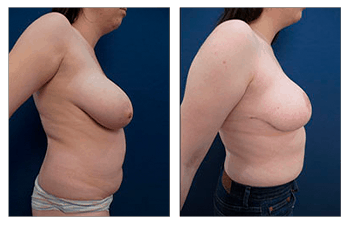




Download Our Surgical Team’s free Liposuction eBook
Breast lift with implant exchange can be a tricky surgery. The surgery obviously requires removal of the implants which should be changed if they are over 10 years old, if they have become compromised such as ruptured, or if there is the thickening of the capsule which is termed capsular contracture. Another reason is to switch from saline to silicone implants.
This is because as we age, our breast skin and soft tissues become thinner. This will result in the firmer saline implants being more visible and less natural in appearance. In addition to the exchange of implants, patients also require a lift to counter the effects of gravity and to lift the breast mounds to a higher more aesthetically pleasing position.
This means repositioning the breast mound from your upper abdomen up to your chest. A breast lift will also help position your nipple on the center of your chest and the center of your newly created breast mound.
Why is Breast Lift with Implant Exchange Tricky?
The breast lift with implant exchange is tricky because it requires undermining of the breast mound to remove the implant along with the capsule when it is thickened which then compromises blood flow to the nipple and areola. This compromise in blood flow is further compounded by the fact that back cuts must be made into the breast to allow for raising of the nipple to its new, desired position.
Modification of traditional surgical maneuvers must be made in order to avoid vascular compromise to the nipple and areola. The first modification involves altering the traditional inferior pedicle to a superior pedicle. The pedicle is the pathway to the nipple and areola that must be preserved to maintain blood flow.
The traditional pedicle allows for blood flow from the bottom up, but since the implant lies over the lower breast pole, this pedicle will get compressed and non-functional. Instead, a superior pedicle is used to provide blood flow to the nipple and areola that is out of the way from compression from the implant.
The final maneuver in a breast lift with implant exchange involves modifying the breast pocket. Often the implants get lateralized meaning that they fall of the chest into the armpit area. This occurs if you do not wear a comfortable bra at night.
When you sleep on your back, the implants will naturally fall out laterally. Similarly, if you sleep on your tummy, you will literally push your implants out laterally.
Lateralization will be accelerated as your breast mounds fall off of your chest onto the upper abdomen, where there are no pectoralis attachments to keep the implants centralized. When performing a breast lift with implant exchange, it is critical to optimize the breast pocket.
This will be done by manipulating the capsule that has formed around the old implant. This capsule can be cut out strategically and also sewed tight with sutures depending on the breast pocket alteration desired.
In summary breast lift with the implant, an exchange is a tricky surgery requiring an experienced breast surgeon.
Please see this 29-year-old female before and after her breast surgery with Our Surgical Team.


